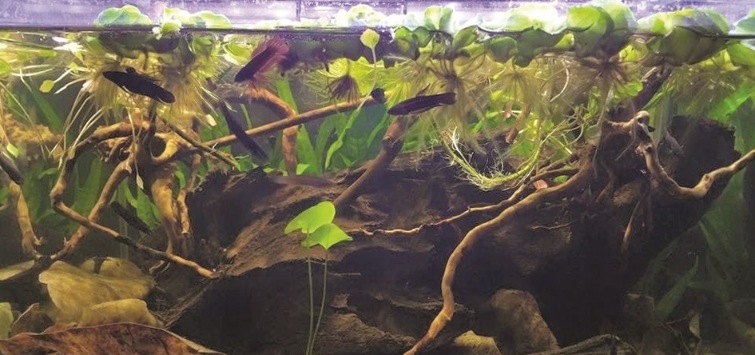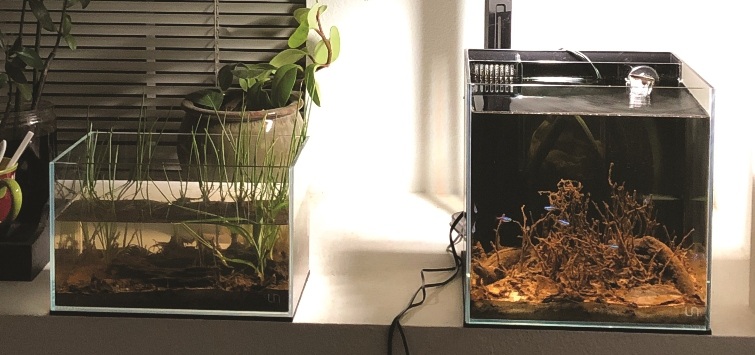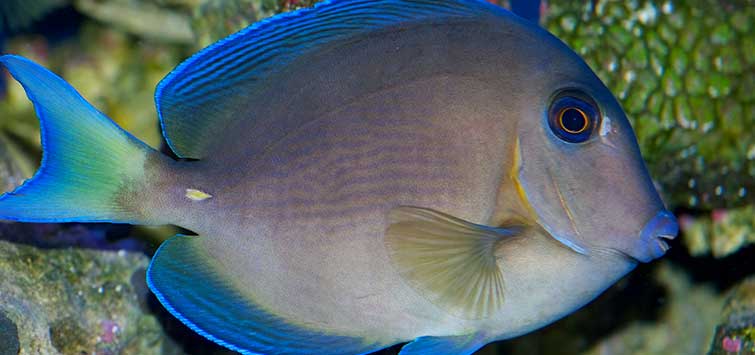Aquascaping a Southeast Asia Biotope
Author: Lea Maddocks
The tropical river systems of the rainforests in Southeast Asia are renowned in the hobby as the origin of many of our most commonly kept fish and plants. Their easy availability means that setting up a basic Southeast Asia biotope is within the reach of aquarists of all skill levels. There are a multitude of interesting options for plants, water chemistry, hardscape design, and livestock for creating an attractive and easy-to-maintain aquarium showcasing some of the region’s most beautiful species.
Southeast Asia comprises such countries as Malaysia, Indonesia, Vietnam, Laos, Thailand, Cambodia, Singapore, Philippines, Brunei, Myanmar, and Timor-Leste, which lie along the equator and feature tropical rainforests and vast, heavily vegetated areas. The climate is generally hot and humid year-round, with moderate to high rainfall throughout the year.
As a result, this region contains numerous river systems, many of which feed smaller streams, peat swamps, and wetland marshes. A lot of these waterways arise from the major river systems, including the Irrawaddy, Salween, Red, Mae Klong, and Chao Phraya. Some span multiple countries and feed complex drainage systems, encompassing a variety of environments on which a Southeast Asia biotope can be based.
In many heavily forested areas, the major waterways are also interconnected by small streams and puddles that can host smaller fish, and these can be successfully reproduced in nano biotope setups. While some smaller streams or marsh areas may shrink or even dry up seasonally, most bodies of water tend to remain within a relatively narrow band of tropical temperatures and humidity, providing a fairly stable environment for both fish and plants despite their smaller water volumes.
Along with these areas, canals (locally known as “khlongs” or “kongs”) also appear in some countries, most notably Thailand. Some are manmade for transport or waste management, but they can host considerable water life if not overused by humans.
Given the breadth of aquatic environments, the choices for aquascape ideas recreating a slice of Southeast Asia are quite numerous. Replicating a very specific area requires a more detailed dive into the local plants, animals, and water conditions, but the following guidelines for a few specific environments are a good starting point from which to jump into further research for your Southeast Asia biotope.
General Conditions
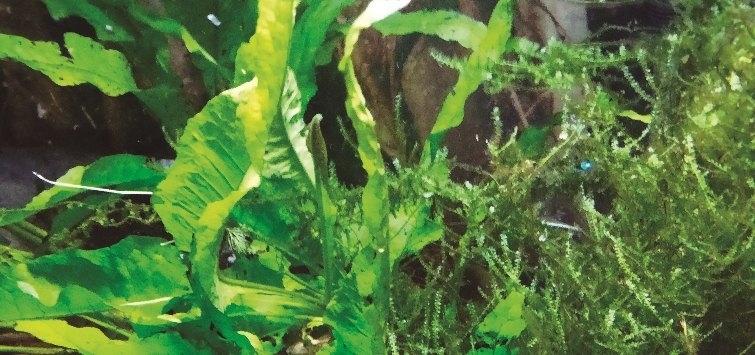
Even though the region is widely variable, we can make a few generalizations about water conditions for most Southeast Asia habitats. Given the forested areas, there will be considerable levels of organics in most waterways, making the water relatively acidic (pH 5 to 7) and usually soft to moderate (GH 3 to 9). Blackwater of varying levels is also common.
These equatorial areas have tropical temperatures that are usually consistent within a range of 68° to 95°F (20° to 35°C), but in an aquarium, a stable temperature between 77° and 82°F (25° and 28°C) will suffice for most fish and plants from the region. Note that if you want to keep anabantoids (bettas, gouramis, etc.), which will want access to the water surface, a well-fitting glass lid is essential to maintain high humidity in the air layer above the water surface. Dry air can harm these fishes’ labyrinth organs, so be mindful of this, especially if you live in a dry area or use air conditioning regularly.
Some level of blackwater conditions would be beneficial and accurate to include for most Southeast Asia biotopes, as most waterways are surrounded by heavy vegetation. These areas are rich in dead and decaying organic matter. Indian almond tree (catappa) leaves are especially useful in replicating this. Other aquarium-friendly leaves such as oak, beech, and maple can also be used to reproduce a natural base. It will stain the water with tannins and help to create a natural leaf-litter base typical of the floors of slow-moving streams, pools, and open swamps.
A little clay in the substrate would also look the part and help provide a rich growing area for plants and beneficial bacteria. A small amount of peat is also a useful aquascaping idea and helps keep pH low.
Minimizing water movement to mimic a slow-moving rainforest blackwater stream or marsh area would be beneficial. Indeed, most anabantoids are not fans of fast-moving water. A gentle, circulating current would, however, be useful to maximize the flow and exchange of gas and nutrients around the tank. A low-powered, submerged spray bar or a few sponge filters may be the best choice for this.
Peat Swamp Forest
The peat swamps of Southeast Asia are a vast habitat of compacted fallen vegetation that has built up on the forest floor and been covered with still water. Quite often, this occurs behind mangroves. As these areas are not drained, an anaerobic environment is created in which organic matter is not decomposed as it would be in aerobic environments, chiefly because the low oxygen levels limit the presence and activity of the microorganisms that would typically do this job.
Plant matter will partially break down, but in these areas it accumulates faster than it can decompose. This leads to the accumulation of organic matter over time, which becomes compacted peat or peat soil. These areas are amazing natural sponges for floodwaters, and as they continue to build up matter and stay waterlogged, the swamps expand over time. Due to the levels of humic compounds present, the water becomes very acidic and deeply stained with tannins. They are also nutrient poor. This creates unique aquatic environments for both animals and plants.
This exact habitat is difficult to recreate in the aquarium, since the thick layers of decomposing matter aren’t something we can replicate easily. Instead, we want to simulate the water conditions as best as possible. A base layer of gravel topped with decaying leaf litter, rich in tannins, is a good aquascaping idea.
Twists of mangrove root wood or tangles of driftwood branches, both under the water and reaching up and out of the tank, lend a natural look and help add additional blackwater. If your local water is hard, consider using a mix of rainwater or RO water to soften it. While natural systems can have a negligible carbonate hardness, we strive to maintain a KH of at least 4° to avoid undue fluctuations in pH.
Plants from the genus Cryptocoryne are native to Southeast Asia and can be found in these swamps. They will cope with the very low pH and dimly lit blackwater conditions, as will Java fern (Microsorum pteropus) and Java moss (Taxiphyllum barbieri). A sponge filter suffices for this kind of biotope, or a very small internal powerhead can be used to very gently circulate water near the surface to encourage some gas exchange.
Tropical Forest Stream
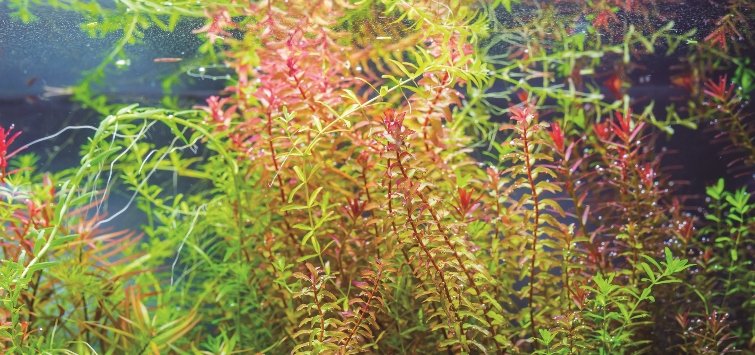
Streams through the tropical forests of Southeast Asia vary in size and flow, but most feature heavy vegetation. Though this dense vegetation and surrounding forest will contribute much of the leaf litter that generates some blackwater conditions, the current of these streams will mean that the water is clearer than peat swamps. For these biotopes, a greater range of plants can be used, as more light will be available.
This is the area where many of our tropical aquarium plants come from. A handful of Aponogeton species are native to this region, including the common A. undulatus, a fairly large plant. Smaller members of the genus, though not native, can also be substituted.
Java moss and ferns also grow here, as do many of the Cryptocoryne. You’ll find the beautiful lily Barclaya longifolia in this habitat, as well.
For stem plants, members of the genera Rotala and Limnophila are common, and many of these will grow above the surface. The selection of possible plants is vast, but you should try to limit it to two to four species in mass plantings so it looks natural. Research the area you want to replicate, and stick to the plant species from as close to that area as possible.
For the substrate, a gravel base topped with a thinner layer of leaf litter or a small amount of clay or peat would do nicely. Small stones and some driftwood resembling fallen branches would make for appropriate hardscaping for this biotope. For current, a small stream at one end of the aquarium from a spray bar or powerhead with outlet set to low just at or under the surface would provide enough circulation and mimic the flow of a stream well.
Livestock
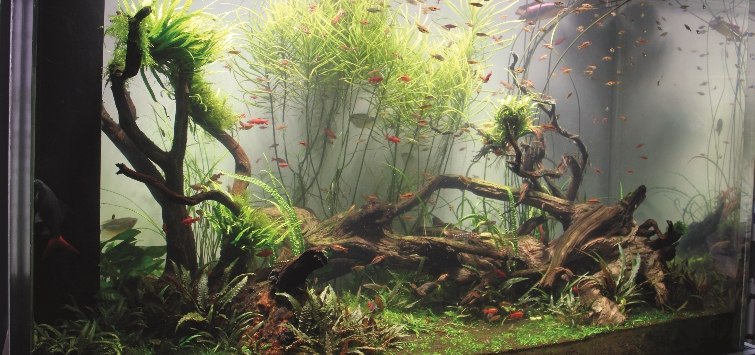
While livestock is a bit outside the scope of an aquascaping discussion, there are some terrific fish from the region that are readily available and ideal for some of these biotopes. Again, research the region you are trying to recreate to see if your livestock matches.
For shoaling fish, it’s hard to pass on the classic rasboras, such as the harlequin rasbora (Trigonostigma heteromorpha) and scissortail rasbora (Rasbora trilineata); or barbs like the gold barb (Barbodes semifasciolatus), tiger barb (Puntigrus tetrazona), Odessa barb (Pethia padamya), and rosy barb (P. conchonius).
You can even showcase the very pretty and active zebra danio (Brachydanio rerio), a fish that is somewhat overlooked these days but can create a spectacular display when kept in numbers in a biotope. A shoal of glass catfish (Kryptopterus vitreolus) can be a fantastic look if kept in a stream biotope with good current for them to swim against.
For interest in the lower strata, you can try a group of clown loaches (Chromobotia macracanthus) if you have the space, or a group of Kuhli loaches (Pangio kuhlii) in smaller aquariums. For feature fish, a small group of wild-type three spot gouramis (Trichopodus trichopterus), lace gouramis (T. leerii), or stunningly simple moonlight gouramis (T. microlepis)—or some combination thereof—can make a terrific Southeast Asian community.
In smaller aquariums, you could consider keeping dwarf gouramis (Trichogaster lalius), honey gouramis (T. chuna), sparkling gouramis (Trichopsis pumila), or licorice gouramis (Parosphromenus spp.), or some wild Betta species like Betta pugnax, B. imbellis, B. livida, etc. Paradisefish (Macropodus opercularis) are also an often-overlooked feature fish for Southeast Asia biotopes, and they can do well in a range of biotope styles given their hardy nature.
A Fascinating Biodiversity
Creating a Southeast Asia biotope can be a fascinating way to learn more about this incredibly biodiverse area, as well as to test your skills in underwater gardening. Because there is a wide range of plants and livestock from this region commonly available in the trade, it is also a good biotope to start with. For more advanced aquarists, there are also many hard-to-find fish and plants to hunt for if you’re looking to recreate a very specific region.
Good luck with your next biotope project!
See the full article on TFH Digital
https://www.tfhdigital.com/tfh/nov_dec_2021/MobilePagedReplica.action?pm=2&folio=18#pg21

.png?h=595&iar=0&w=2781&hash=5FD5E69473BCC22199FBFA2FB71B6033)
